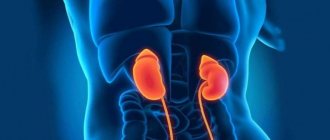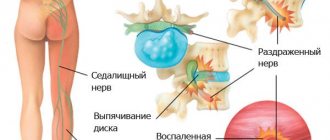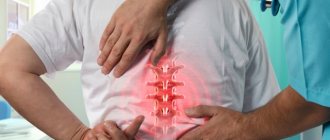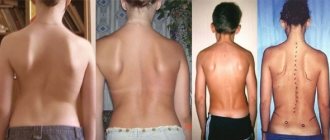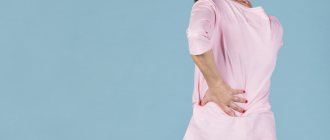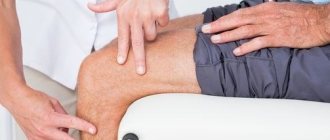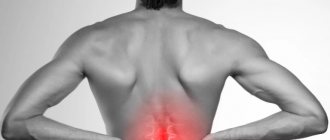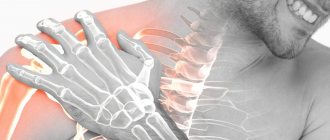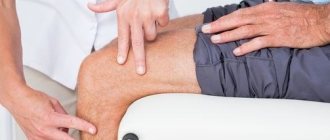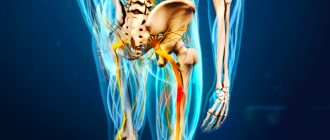Sharp and throbbing pain that occurs in the lower back, often radiating to the buttock and leg. Painful sensations can occur suddenly and have an increasing character. The pain syndrome spreads from the sacrum to the buttocks, and then moves to the lower extremities.
Those at risk include elderly patients, people doing heavy physical work and office workers who spend a lot of time in a sitting position. Treatment of pain radiating to the buttock is aimed at identifying the pathology and eliminating all negative sensations.
Complications
Pain radiating to the buttock can occur for the following reasons:
- lower back diseases affecting the sacral or coccygeal spine;
- intervertebral hernia;
- osteochondrosis;
- radiculitis;
- inflammation of the sciatic nerve;
- spinal injuries;
- malignant neoplasms;
- some diseases of internal organs (anal abscess, hemorrhoids, inflammation of the urogenital area).
Lack of treatment for pain in the lower back and buttocks leads to serious complications: increased pain, impaired mobility of the spine and muscles, and loss of the ability to move independently.
Tip for the doctor
To help your doctor make a diagnosis, tell him in detail how and when your lower back and left or right buttock hurt. For example, pain appears in the morning, but by the time you come to work it becomes tolerable. Maybe the pain wakes you up at night. It may occur after physical activity or in the late afternoon. Your attending physician needs to know all these nuances in order to establish a diagnosis as quickly as possible and move from maintenance therapy to treatment of the causes of the disease.
Diagnosis of pain radiating from the lower back to the buttock
Since pain can occur for various reasons, the patient requires a comprehensive diagnosis and consultation with several specialists (urologist, gynecologist, gastroenterologist, oncologist).
Diagnostic measures include:
- general blood and urine analysis, biochemical blood test;
- Ultrasound of the abdominal organs;
- X-ray;
- performing computed tomography and magnetic resonance imaging;
- electromyography.
Treatment can be prescribed after a complete examination.
When is urgent medical attention needed?
Acute pain, accompanied by fever, numbness of the limbs, gait disturbance, and confusion, means that the person requires urgent medical attention. The main task is to relieve pain. To do this, you need to help the person take a comfortable position in which the least pain is felt.
To relieve pain, you will need to administer painkillers, preferably by injection. Light massage, compresses, and rubbing the lower back with warming ointment are effective.
Prevention of lower back pain radiating to the left leg
Severe pain interferes with everyday life: it interferes with daily physical activity, limits professional opportunities, and causes deterioration in mood and stress.
To avoid negative consequences, you should follow simple preventive measures:
- Introduce morning exercises, stretching exercises, and functional training into your daily routine.
- Take care of your diet: eat 3-5 times a day at regular intervals, consume enough proteins, fats and carbohydrates, plant fiber, vitamins. Eliminate alcohol, smoked meats and canned foods from your diet.
- Avoid dehydration: consume 1.5-2 liters of fluid per day.
- Take courses in classical, cupping or warming massage.
- Monitor your posture and body position both during working hours and during rest.
Human health consists of many little things. If you follow simple recommendations every day, you can never experience lower back pain.
Treatment of buttocks and lower back
Treatment tactics depend on the disease causing the pain, the patient’s age, the presence of concomitant diseases, and the severity of the pain syndrome.
Complex treatment involves the use of drug therapy, including vitamin complexes, physiotherapy, exercise therapy, and acupuncture.
Drug treatment
Since the main goal of treatment is pain relief, the patient is prescribed various painkillers. They can be in injections, tablets, ointments. There are the following groups of medications that are prescribed to relieve pain, inflammation and swelling:
- non-steroidal anti-inflammatory drugs – Nimesulide, Ibuprofen;
- analgesics – Paracetamol;
- muscle relaxants – Sirdalud, Baclofen;
- chondroprotectors – Chondrolon, Khonsurid.
- combined agents - Ibuklin, Gevadal.
The listed drugs effectively relieve pain and inflammation, improve blood circulation and help improve joint mobility. But they are not able to eliminate the cause of pain, so they must be complemented by other treatment methods.
Physiotherapy
In complex treatment, the patient is prescribed various therapeutic procedures. The most effective include electrophoresis based on drugs, ultrasound, laser therapy, magnetic therapy, and the use of paraffin and mud applications.
Physiotherapeutic procedures are carried out during the recovery stage, but they are prohibited at elevated temperatures during an exacerbation of the disease.
Vitamins
B vitamins are included in the list of mandatory medications prescribed for pain in the lower back and buttocks. They are prescribed for pain caused by osteochondrosis, radiculitis, and intervertebral hernia.
Preparations Trigamma, Kombilipen, Milgamma contain B vitamins and lidocaine. This combination has an analgesic, anti-inflammatory, and restorative effect.
Exercise therapy
A set of physical therapy exercises is indicated for patients with various disorders of the musculoskeletal system, and can also be recommended for many other diseases.
Physical exercise improves blood circulation, speeds up metabolism, strengthens muscles, and helps them relax. Exercises will be effective if done regularly.
Acupuncture
Acupuncture is one of the most effective complementary treatment methods. The procedure helps relieve pain, regenerate joint tissue, increase tone, and strengthen the immune system. Acupuncture is most effective at the initial stage of the disease.
Secrets of therapy
As in other cases of back pain due to muscle strain, painkillers and muscle relaxants are used for pain in the lower back and buttocks. But, unfortunately, one cannot expect a complete cessation of pain from them. The main treatment is manual therapy, osteopathy, massage, therapeutic exercises (physical therapy). For severe pain, the Neurac neuromuscular activation method using the RedCord suspension system gives good results. Auxiliary procedures include various physiotherapeutic methods: magnetic therapy, electrophoresis and others.
How to relieve an attack of pain on your own?
The main condition for eliminating pain and alleviating the patient’s condition is to provide him with complete rest. The patient should be helped to lie on a hard surface or on an orthopedic mattress. It is important to remain calm and not make sudden movements of the body.
Relaxation is facilitated by lying on your stomach; you can also lie on your back with slightly bent legs, placing a pillow or cushion under your shins.
To relieve pain, take a painkiller. The reception is carried out within 2-3 days. During the treatment period, self-massage of the lumbar region with the pads of the fingers in a direction from top to bottom is indicated.
Complex treatment is prescribed by the doctor, taking into account the severity and main symptoms of the disease.
Nature of pain
In the process of interviewing the patient, information about both the nature and duration of pain is important. The main criterion by which the doctor determines the further treatment strategy or prescribes additional diagnostics is the nature of the pain.
Most often, problems in the lumbar region are accompanied by cutting pain. In this case, unpleasant sensations arise quickly: for example, when pinched. Descriptions of shooting and radiating pain are also not uncommon. Shingles are less common.
Below are the main types of lower back pain, in which discomfort can spread to the legs:
- Koreshkovaya. Occurs when the root of the spinal nerve running inside the spine is damaged. Such pain is more often called radiating pain, because it tends to be transferred to organs and limbs that are not involved in the process of damage to the root. Often radicular pain is reflected in the cervical region, the heart area and the stomach.
- Spicy. Appears instantly, sharply, immediately becomes strong and does not weaken over time. In case of injuries or after a long stay in an uncomfortable, unnatural position, it is short-term; in the case of an advanced pathological process, it does not stop without emergency medical intervention.
- Pulling. It appears gradually and the intensity increases over time. Described as wave-like pain sensations migrating down from the source and returning back. They are protracted, may disappear, but, as a rule, appear again.
Having determined the nature and location of the pain, the doctor begins to make assumptions about the source of the disease and determines with additional diagnostics.
Kinesitherapy for pain in the buttocks and lower back
Kinesitherapy is one of the most effective methods of treating musculoskeletal disorders and associated pain in the buttocks and lower back.
In our kinesitherapy Center, we have developed special exercises on simulators that activate the process of tissue restoration, eliminate pain and spasms, optimize blood flow, and saturate with energy and vitality.
You can visit our Centers in Zelenograd, Tver, Dubna and Klin. We employ qualified specialists who have extensive experience in the rehabilitation of patients with even the most complex pathologies of the spine and joints. Our method of treatment and recovery will relieve you of excruciating pain and help you return to a full life.
Forget about pain forever
To avoid suffering from back pain associated with muscle strain, you need to change a lot in your life. It is important to solve orthopedic problems and properly arrange the working and sleeping space.
When working sedentarily, the only way to save your back is to take breaks and exercise minutes several times a day. A set of gymnastic exercises before or after work will help restore blood flow to the muscles and give them a varied load. This is a good way to prevent overexertion due to static postures.
Regular exercise will help make remission (a state where the patient is not bothered by the disease) long-lasting, and regular exercise in many cases will help say goodbye to back pain forever.
MESSAGE FROM THE CHIEF DOCTOR:
Often, when examining a patient, doctors pay attention only to the bones, ligaments, and joints. At the same time, nothing is said about muscles
, the function of contraction of which plays a significant role in human life. Weakened muscles lead to thinning and deformed bones.
Unfortunately, common methods of therapy only aggravate the situation, leading to even more severe pain, muscle atrophy and a deterioration in the quality of life of patients.
Effective treatment is impossible to imagine without muscle restoration. Unique kinesitherapy technique
consists in a therapeutic effect, which implies, first of all, muscle activity during the methodical execution of a set of exercises on special simulators.
All exercises are performed by patients sitting or lying down, so there is no excessive stress on the joints and circulatory system, and our instructors-methodologists correct the technique of movements
and monitor the correct execution of actions.
Remember that diseases of the spine and joints are not a death sentence; if the patient wishes and the right approach to treatment, everything can be corrected!
Causes of pain
In most cases, pain in the lower back and left leg is caused by injuries or diseases of the spinal region. One of the most common symptoms is muscle spasms, which are interpreted by the patient as a short-term reaction to a sedentary lifestyle or an uncomfortable sleeping position.
Often these reasons are the source of pain. However, there are more serious factors, which include infections, inflammatory processes, and cancer.
These reasons have negative consequences. To avoid them, at the first appearance of lower back pain, you should immediately consult a doctor.
We list the main causes of lower back pain radiating to the left leg:
- Hypothermia. Sudden temperature changes can trigger the appearance of myositis - inflammation of muscle tissue in the lumbar region. The main symptoms of hypothermia include nagging pain that does not go away over time, hardening of muscle areas, and increased pain upon palpation. Often the pain migrates and radiates to the leg and buttock on the affected side. Sometimes myositis entails increased body temperature, redness and itching in the lumbar region.
- Protrusion of intervertebral discs. One of the variants of intervertebral disc herniation, in which the disc bulges into the spinal canal. The dimensions of the protrusion range from 1 to 3 mm. The main prerequisites for the appearance of a hernia are incorrect posture, weak muscular skeleton, obesity, spinal column injuries, high loads on the spinal region, including sports, and past infectious diseases. Symptoms of protrusion include weakness, stiffness of movement, coldness in the legs, and pain spreading to the limbs.
- Diseases of the sciatic nerve. The most common of the spectrum of diseases is sciatica - a pinched nerve, which is accompanied by acute pain and limited mobility of the body. Often there is a shooting pain directed to the back of the thigh or lower leg. The causes of pinching are systematic hypothermia, heavy lifting with weight transfer to the back, sudden unnatural movements in the lower back.
- Osteochondrosis. This is a disease of the cartilaginous surfaces of the bones of the musculoskeletal system, which often affects the spinal column. Appears as a result of constant sharp turns, bending and straightening of the body, playing sports without mandatory insurance, improper lifting technique and incorrect posture for sleeping and resting. Osteochondrosis causes aching pain in the lower back, which radiates to the legs, numbness of the limbs and increased pain during shaking and sudden movements of the body.
- Neuropathy. This disease occurs due to dysfunction of the sciatic nerve. The causes of neuropathy include injuries to the nerve, surrounding tissues and subsequent compression of the nerve by damaged muscles, as well as degenerative diseases of the nervous system. Neuropathy causes loss of sensation in the foot and impaired movement of the toes. In advanced cases, trophic ulcers form.
- Hernia. Unlike protrusion, it has a size from 3 to 15 mm. Symptoms of a hernia include constant lower back pain, surges in blood pressure, weakness, pain in the heart, dizziness and headache, numbness in one of the legs, and loss of sensation in the genitals. In advanced cases, a hernia of the spine provokes paralysis, paresis, and disruption of the functioning of internal organs.
- Osteoporosis. Consists in reducing bone strength. The bone material becomes more porous and brittle. The causes of the disease can be primary - heredity, disruption of the ovaries in women, old age - and secondary: diabetes, kidney disease, blood disease, thyroid disease, oncology. With osteoporosis, severe pain is observed that spreads to the leg, arm, abdominal area and thoracic region. Fractures and deformation of bones and joints are also possible.
- Sciatica. This is an aching and growing pain in the lumbar region, radiating to one or both legs. People over 30 years of age who are subject to frequent stress and depression are predisposed to this disease. Incorrect posture and heavy physical labor also cause lumbar sciatica. In general, this disease is a consequence of a vertebral hernia. Symptoms include severe migrating pain, limited mobility of the lumbar region, inability to step on the foot, changes in temperature and color of the skin of the legs.
- Oncology. Sometimes the cause of lower back pain that radiates to the left leg is cancer. In this case, pain is caused by metastases located in the bones, multiple myelomas, i.e. tumors, and primary spinal tumors - neoplasms that originally appeared in the spinal column. A distinctive feature of pain caused by cancer is its constant nature and manifestation mainly at night. An increase in temperature to 37-37.5 ° C, weight loss and a decrease in the patient’s height can also be a sign of the development of oncology.
Lower back pain can be caused by a wide range of medical conditions. To minimize risks, preventive measures should be taken.
